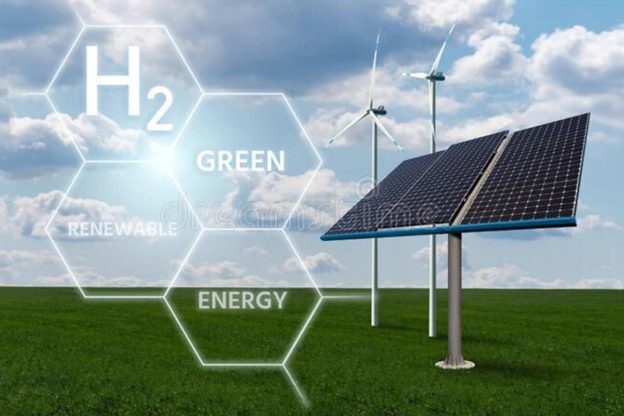The future of humanity lies with green hydrogen, which is free from carbon emissions. The use of green hydrogen is particularly effective in ensuring a smooth transition towards renewable energy. Moreover, it can be pivotal in helping India meet its Paris Agreement commitments. It can help India reduce emissions released by some of the most polluting industries like steel, shipping, and refining.
India relies on coal, oil, and solid biomass to meet 80 percent of its energy demand and fulfil 85 percent of oil needs from overseas locations. The country needs an energy consumption pattern that promotes energy independence and reduces the carbon footprint. The development of renewable energy sources opens up channels for decarbonisation and cutting reliance on overseas energy sources. But how do we control the risk of grid collapse due to unpredictability and mismatch in the generation and consumption of renewable energy? Well, there is just one answer – green hydrogen.
Hydrogen is the most abundant element found in nature. Until recently, the use of hydrogen didn’t have an environment-friendly dimension. Most of the hydrogen was extracted through a process called steam methane reformation (SMR) of natural gas. The process emits a large amount of carbon dioxide and contributes to increasing carbon footprint.
However, the future of humanity lies with green hydrogen, which is free from carbon emissions. It is produced by the electrolysis of water with renewable power, which is a zero-emission process. It involves splitting water molecules into hydrogen and oxygen using renewable energy sources like onshore and offshore wind power, solar power, and hydropower. However, green hydrogen is more expensive than other fuels as it involves the application of renewable energy in the production process.
Investments in green hydrogen are already going up. The fuel has several applications, including supplying raw materials to industries, running automobiles with fuel cells, and enhancing renewable energy storage to make it a viable alternative for replacing non-renewable energy.
The use of green hydrogen is particularly effective in ensuring a smooth transition towards renewable energy. Transitioning to a power sector dominated by renewable energy would lead to a situation in which peak production would be restricted to non-peak mid-day hours. And peak demand will be concentrated in the mornings and evenings when renewable energy generation might be uncertain. This would lead to grid instability and the risk of excess production unless and until a long-term storage solution is found. Green hydrogen offers this solution.
Production of green hydrogen can take up excess renewable energy. One can store the green hydrogen produced in the process in hydrogen tanks or fuel cells that can convert stored hydrogen into electricity. Alternatively, it can also be used to produce synthetic methane and solve the storage problem in a renewable energy-dominated power sector.
The use of green hydrogen can be pivotal in helping India meet its Paris Agreement commitments. During the recent COP26, India has voluntarily committed to achieving net-zero emissions by 2070. To achieve this target in the time frame, India needs to substantially scale its renewable energy capacity.
Green hydrogen can help India reduce emissions released by some of the most polluting industries like steel, shipping, and refining. These industries involve heavy use of natural gas/coal. By replacing high-emission fuels with green hydrogen, India can cut down drastically on carbon emissions.
India is now embracing green hydrogen as the pivotal point of its future strategy to reduce emissions. During his 2021 Independence Day speech, Prime Minister Narendra Modi announced the launch of the National Hydrogen Mission. The plan is to make India a global hub of green hydrogen production and imports, which will make India an energy-independent nation and transform it from an energy importer to an energy exporter.
Also Read // Adani, RIL, Tata bet big on green energy
Oil refining, fertilisers, steel, heavy-duty transport and industrial heat are some of the sectors expected to bolster demand for green hydrogen. Government plans to stipulate a minimum of 10 percent green hydrogen use by refineries from 2023-24, with a gradual increase to 25 percent over the next five years. Similarly, there are plans to set a 5 percent compulsory green hydrogen use threshold for fertiliser industries starting 2023-24, with a gradual increase to 20 percent over the next five years.
Oil refineries and fertiliser firms are already using large quantities of hydrogen. As per TERI, 6 million tonnes of hydrogen is used by India. However, most of the hydrogen industries consume is grey, cheaper than green hydrogen. The main challenge for policymakers is to change market demand and cause a shift from the use of grey to green hydrogen.
India is blessed with abundant renewable energy sources like wind energy, solar energy and hydro energy. However, optimum utilisation of renewable energy demands investment in green hydrogen to ensure the practicable use of electricity generated by renewable sources. India thus has an opportunity to revolutionise energy consumption patterns and ultimately become a net exporter of green hydrogen, which is set to become the principal global fuel in the coming years.
https://www.cnbctv18.com/energy/green-hydrogen–indias-ticket-to-an-energy-independent-future-11981332.htm/amp





